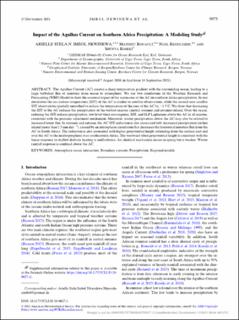| dc.contributor.author | Nkwinkwa, Arielle Stela Imbol | |
| dc.contributor.author | Rouault, Mathieu | |
| dc.contributor.author | Keenlyside, Noel Sebastian | |
| dc.contributor.author | Koseki, Shunya | |
| dc.date.accessioned | 2021-11-30T09:01:36Z | |
| dc.date.available | 2021-11-30T09:01:36Z | |
| dc.date.created | 2021-11-27T21:30:32Z | |
| dc.date.issued | 2021 | |
| dc.identifier.issn | 0894-8755 | |
| dc.identifier.uri | https://hdl.handle.net/11250/2832019 | |
| dc.description.abstract | The Agulhas Current (AC) creates a sharp temperature gradient with the surrounding ocean, leading to a large turbulent flux of moisture from ocean to atmosphere. We use two simulations of the Weather Research and Forecasting (WRF) Model to show the seasonal impact of the warm core of the AC on southern Africa precipitation. In one simulation the sea surface temperature (SST) of the AC is similar to satellite observations, while the second uses satellite SST observations spatially smoothed to reduce the temperature of the core of the AC by ~1.5°C. We show that decreasing the SST of the AC reduces the precipitation of the wettest seasons (austral summer and autumn) inland. Over the ocean, reducing the SST reduces precipitation, low-level wind convergence, SST, and SLP Laplacians above the AC in all seasons, consistent with the pressure adjustment mechanism. Moreover, winter precipitation above the AC may also be related to increased latent flux. In summer and autumn, the AC SST reduction is also associated with decreased precipitation farther inland (more than 1.5 mm day−1), caused by an atmospheric circulation that decreases the horizontal moisture flux from the AC to South Africa. The reduction is also associated with higher geopotential height extending from the surface east and over the AC to the midtroposphere over southeastern Africa. The westward tilted geopotential height is consistent with the linear response to shallow diabatic heating in midlatitudes. An identical mechanism occurs in spring but is weaker. Winter rainfall response is confined above the AC. | en_US |
| dc.language.iso | eng | en_US |
| dc.publisher | American Meteorological Society | en_US |
| dc.title | Impact of the Agulhas Current on Southern Africa Precipitation: A Modeling Study | en_US |
| dc.type | Journal article | en_US |
| dc.type | Peer reviewed | en_US |
| dc.description.version | publishedVersion | en_US |
| dc.rights.holder | Copyright 2021 American Meteorological Society. | en_US |
| cristin.ispublished | true | |
| cristin.fulltext | original | |
| cristin.qualitycode | 2 | |
| dc.identifier.doi | https://doi.org/10.1175/JCLI-D-20-0627.1 | |
| dc.identifier.cristin | 1960254 | |
| dc.source.journal | Journal of Climate | en_US |
| dc.source.pagenumber | 9973-9988 | en_US |
| dc.relation.project | EC/H2020/817578 | en_US |
| dc.relation.project | Norges forskningsråd: NS9039K | en_US |
| dc.relation.project | Notur/NorStore: NN9039K | en_US |
| dc.relation.project | Norges forskningsråd: 234205 | en_US |
| dc.relation.project | EC/H2020/648982 | en_US |
| dc.relation.project | Norges forskningsråd: 309457 | en_US |
| dc.identifier.citation | Journal of Climate. 2021, 34 (24), 9973-9988. | en_US |
| dc.source.volume | 34 | en_US |
| dc.source.issue | 24 | en_US |
